As a card-carrying member of what Michael Bane refers to as “Gun Culture 1.0,” I started my shooting days with the .22 Long Rifle. I suppose, if I want to be technical about it, my first shots were actually fired from a Crossman pellet gun (with lots of assistance from my dad and my grandfather) in the desert near the Salton Sea, but all the shooting that followed happened with the rimfire.
It would be several more years before I shot my first centerfire gun (my dad’s Colt Python—talk about starting off on the right foot!), and while that was certainly a notable milepost on the highway of my childhood, it was definitely the exception to the rule. Until my teen years, the .22 LR, in various guises, was my range companion.
The Suburban “Hunter”
As a suburban kid, whose shooting was mostly done on police ranges, I didn’t grow up shooting small game with the .22. My “prey” was the unforgiving paper target, the explosive soda can, and the defiant 12 Ga. shotgun hull, standing in formation alongside several more, just daring you to knock them over (betcha can’t go ten for ten!). I once embarked on a lizard safari in the corner of the range, where I sent one off to its maker with a well-placed shot, but that was about the extent of my “hunting” experience, until the trip to McCain Valley.
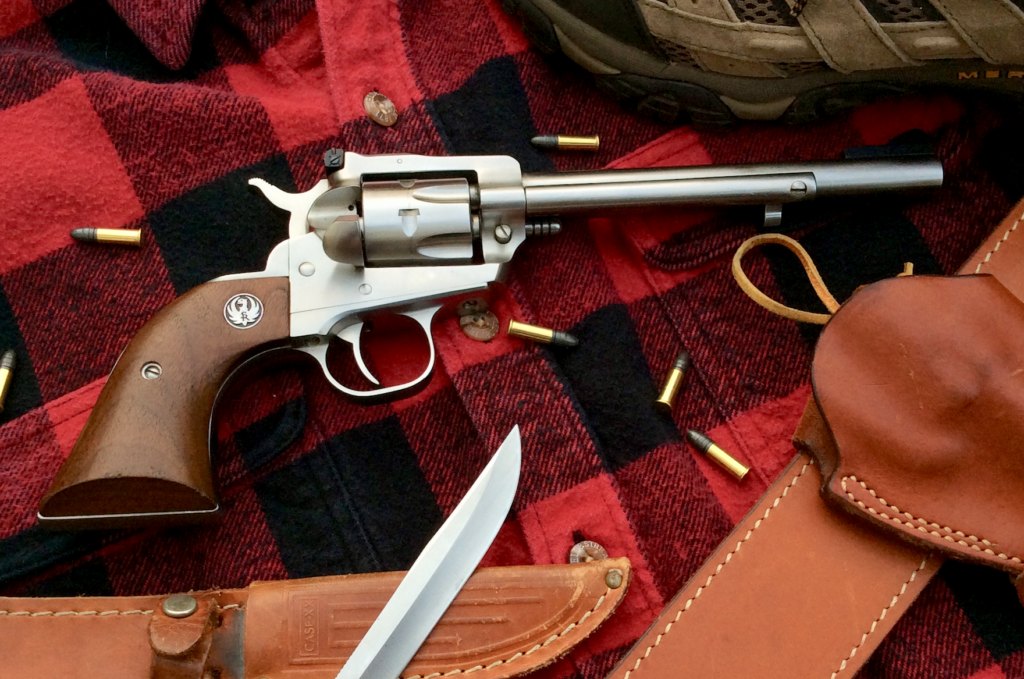
McCain Valley lies about 70 miles east of San Diego, in the coastal mountains of Southern California, and in the early 1980s, young teens could still hike its boulder and chaparral-covered landscape with .22s in their hands and blood lust in their hearts. Any snake, jackrabbit or ground squirrel who didn’t seek cover was fair game for the would-be hunters that prowled its environs!
It so happened, on my inaugural trip to the valley, that I got the opportunity to shoot my first ground squirrel. The squirrel made a perfect silhouette as he sat on top of the decaying fence post, which had once supported a barbed wire fence to hold the cattle in. With all the focus I could muster, I knocked him off that fence post with a single round from my .22 rifle, but was shocked to see him recover, run several yards, scurry down his hole, and disappear forever.
I thought for sure the 36 grain, high velocity bullet would have incapacitated him right away, leaving him anchored right there, but it was not to be. Maybe if I’d made a head shot, but the body shot with the little round nose lead .22 bullet just didn’t deliver the knockout punch I envisioned. I’m sure he didn’t last very long after he made it to the hole, but he did manage to escape the stew pot that night with his final sprint, and he also taught me a valuable lesson about terminal ballistics, and not expecting too much of any bullet.
Roy’s Tinkering
I was thinking about that squirrel as I unwrapped the package I’d received in the mail from RevolverGuy friend, and all-around-gun-guy, Roy Huntington.
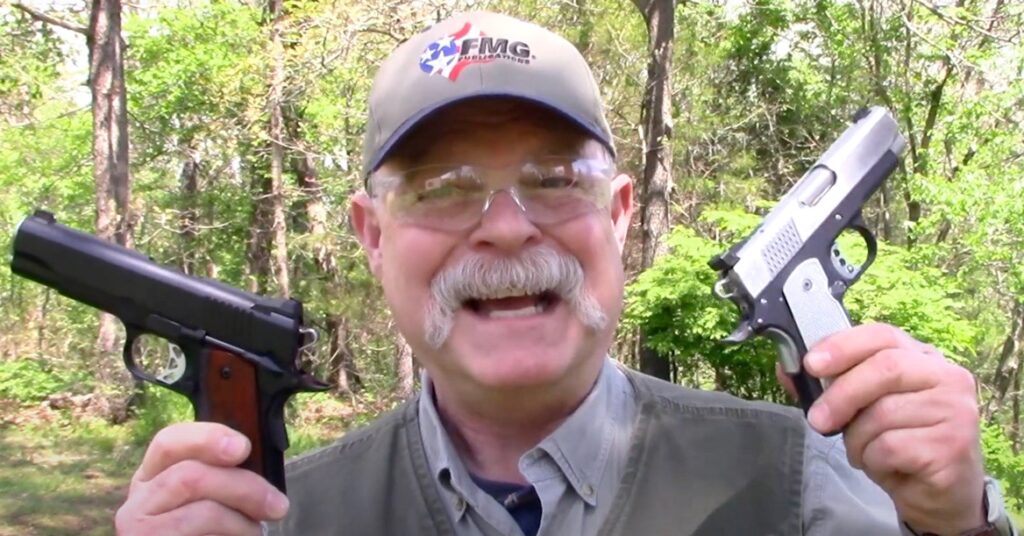
Those who have followed Roy in the pages of American Handgunner and Guns Magazines for decades know that he’s an inveterate gun tinkerer. At least, that’s how he would describe himself—as an enthusiast tinkerer. In actuality, Roy’s a talented machinist who can do 80% of the classic gunsmith’s work, and is quickly learning how to do the other 20%.
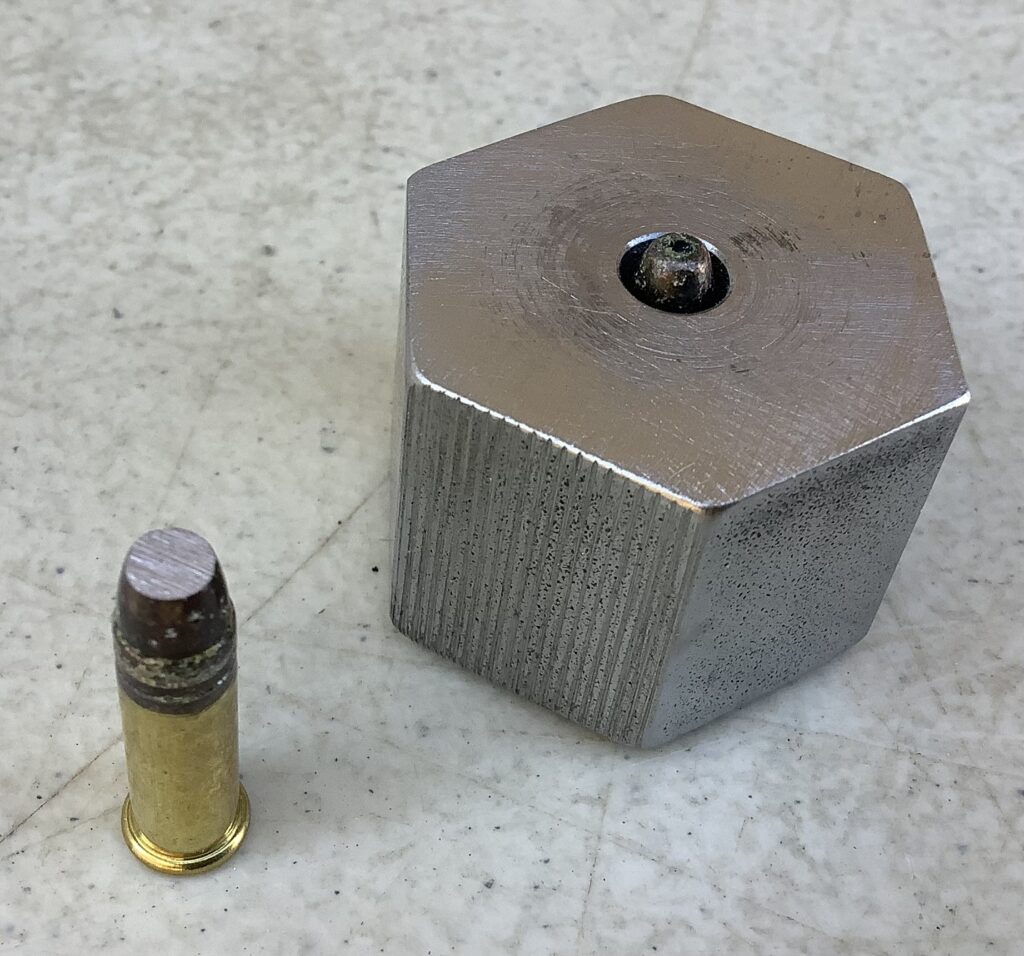
Formal titles aside, Roy loves to play around in his shop and work on gun projects of all types. He’s always got something cooking, and in one of our email conversations, he told me about one of his latest—a simple die that allows you to put a flat point on a round nose .22LR cartridge. I was interested in both the tool and the concept, so he was kind enough to send me a sample of his latest design for doing the conversions.
Not the New Kid on the Block
The idea of flat-pointing a .22 LR bullet is nothing new. Industry veteran Ed Harris told me about Pre-WWII dies for flat-pointing .32 and .38 caliber rounds, and I’ve read about similar tools for the rimfires.1 I seem to recall that it became very popular to flat point .22s during the Depression years, when it was a very attractive proposition to make the economical .22 LR hit much harder than it normally would, ensuring that you’d both fill the pot and save valuable ammunition.
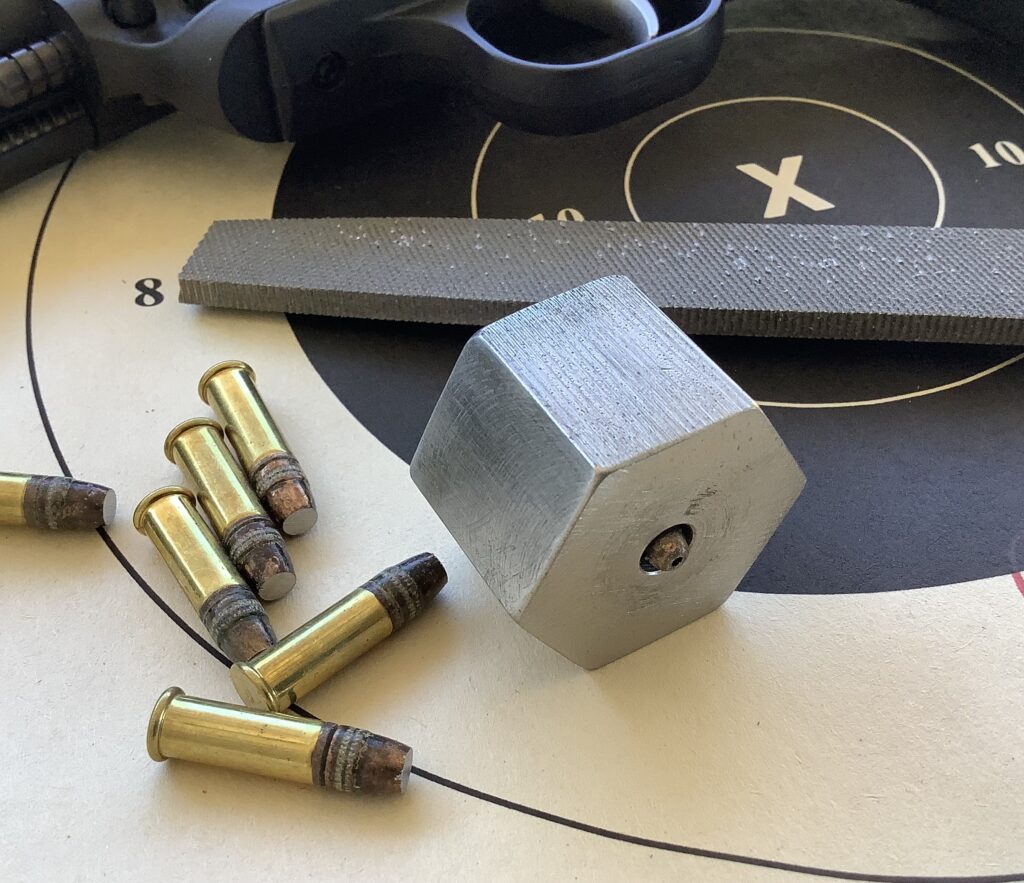
There have been a number of folks over the years who have made clever tools for flat-pointing and hollow-pointing rimfires, some of which are still in production. Paco Kelly’s tool for flat pointing rimfires is quite popular (as are his tools for accurizing and hollow-pointing rimfire bullets), and so is Neal Waltz’s die set.2 Custom gunsmith, and RevolverGuy friend, Gary Reeder also makes a tool for flat pointing rimfires that is well regarded.

Roy’s tool is simplicity in itself, though. The die allows you to chamber a Long Rifle on one end, then clip or file the tip off on the other. I found it easy to grind off the tip with just a few light strokes on a cheap file, as I worked the die across it. By the way, Roy has done the same operation on 115 grain 9mm FMJ ammo with great success.
Effect on Game
The whole point of putting a flat point on a .22LR cartridge is to improve its effect on game, and to hear Roy describe it, the flat point really does magic for the rimfire. In our conversations, Roy indicated that the flat point ammo hits MUCH harder on small game, with a tell-tale “thwap” when it strikes, and it stops little critters like ground squirrels dead in their tracks. They don’t get up and run away like the ground squirrel in my opening story did, they just get anchored.
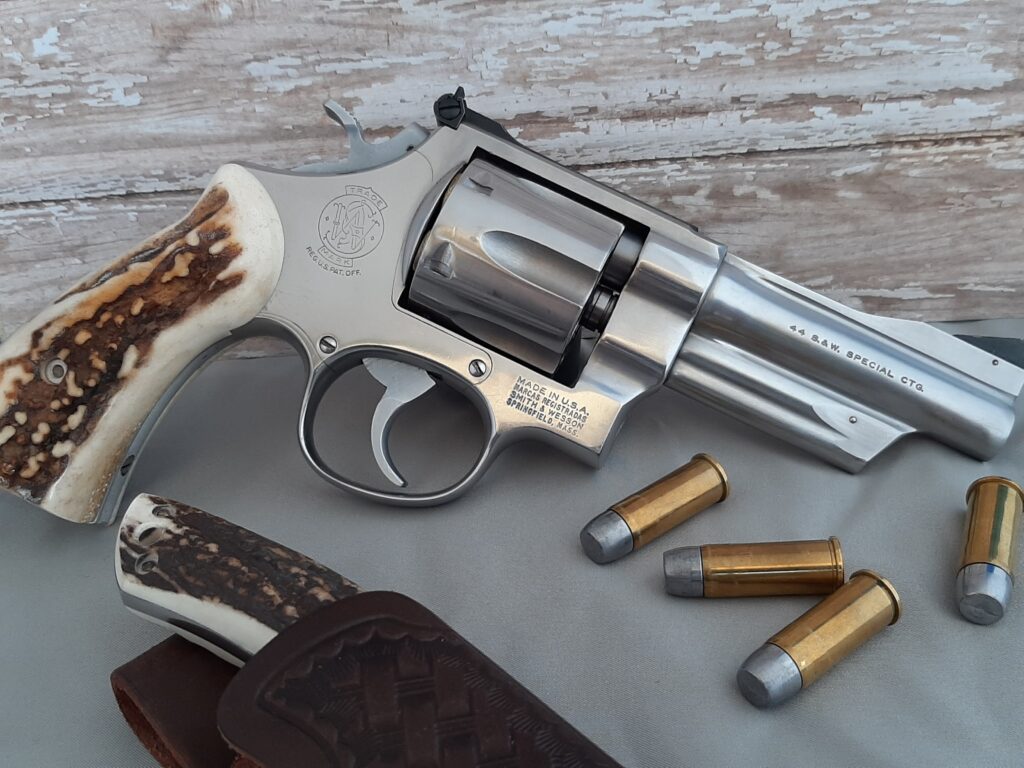
The flat points do a lot more damage in the target, which probably doesn’t surprise anyone who’s a fan of the late Elmer Keith. Keith, you’ll recall, pioneered semiwadcutter handgun bullet designs with large, flat meplats for greater game-killing power in the .44 and .45 caliber sixguns that he liked to hunt with. To this day, the Keith-style bullets still rule the handgun hunting fields, because they work. Those large, flat noses deliver a lot of shock, destroy a lot of tissue, and make the bullet track straighter in the target than a round nose projectile would. They also have less propensity to skip off a rounded surface (like a skull or rib), and dig into the target, instead.
Suburban Safari
I still don’t live in a rural environment that would easily afford me the opportunity to try these flat points out on small game, but I do have access to a facility that will let me shoot one of the most popular species of “small game” around—the Sodacanis Americanis.
Following the most intensive scientific protocols, I designed an exhaustive test that would allow me to conclusively evaluate the flat point alongside its 36 grain, hollow point parent . . .
Nah, actually I just blew up some soda cans! But between the boyish hoots of laughter that involuntarily sprang forth from every jumping, spraying can, I could definitely tell that the flat points manufactured from the Federal 36 grain High Velocity hollow point bullets hit a LOT harder than the unmodified Federal hollow points did.
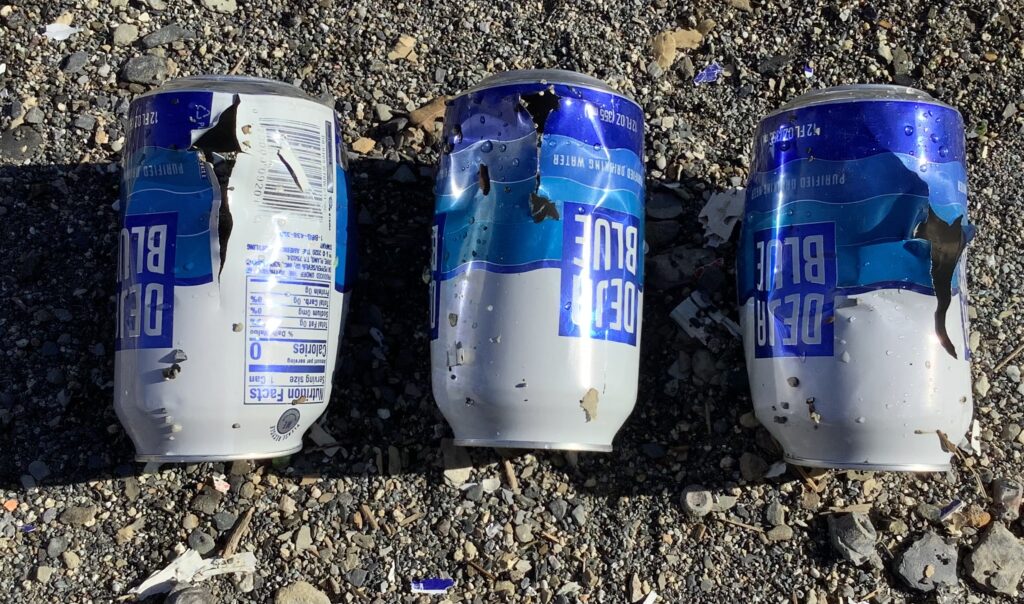
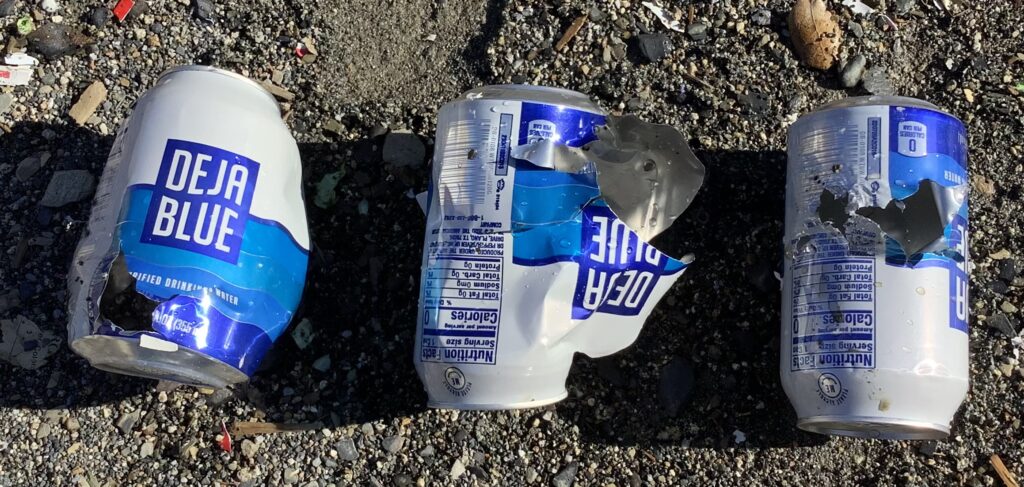
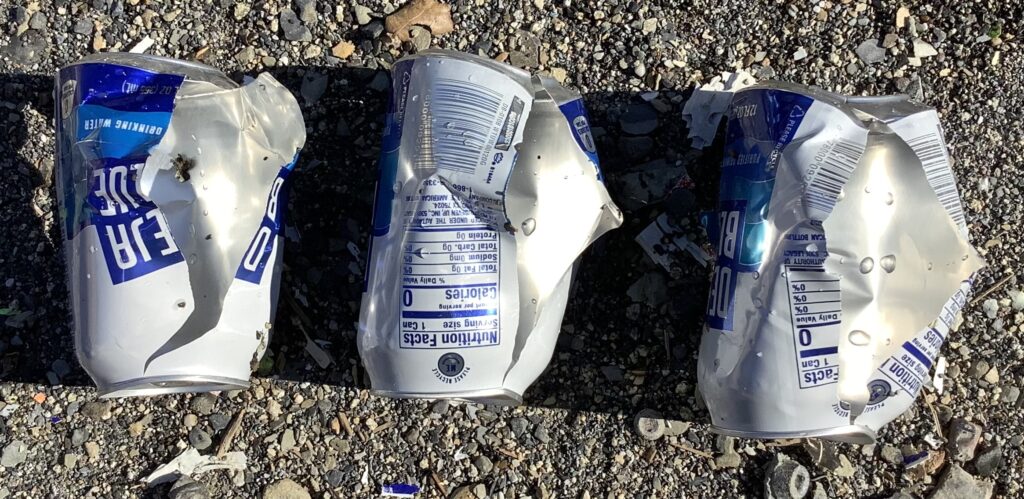
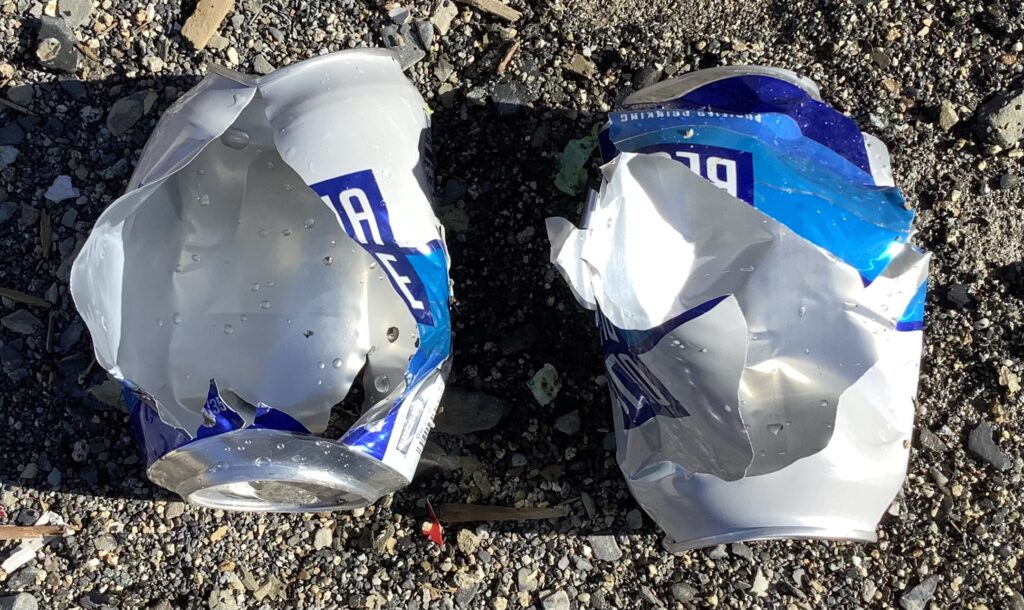
The flat noses struck the cans with a very satisfying smack, and the force of the impact knocked the cans back a full two feet from where they started, well beyond the resting point of the cans hit with the unmodified hollow points (which only got pushed back a few inches). The twisted, mangled remnants of the cans testified that the flat points were more destructive than the hollow points, too, with the entry wounds exploding outwards from the intense pressure. The exit wounds seemed greater as well, but the real proof was in watching the cans hit with the flat points go jumping like they’d been hit by lightning.
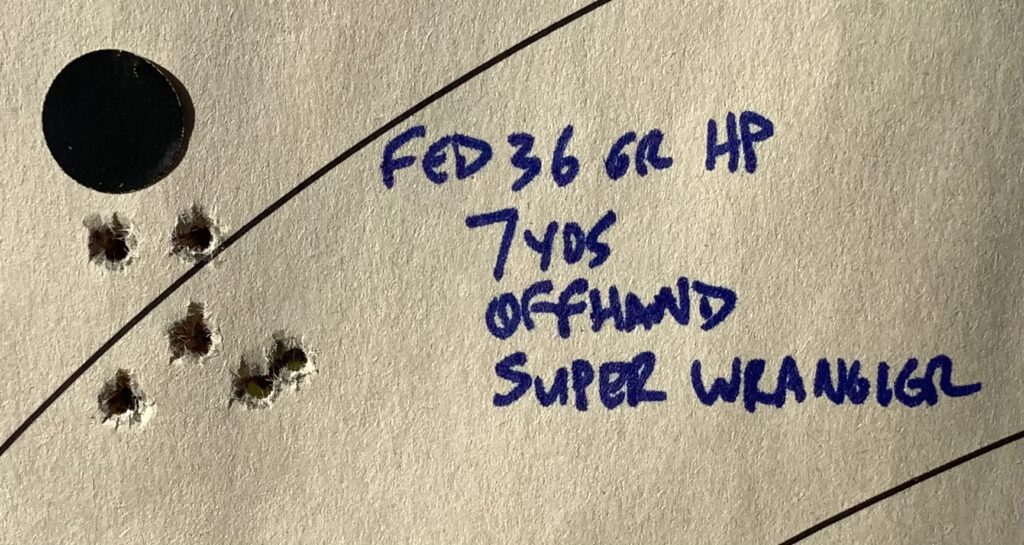
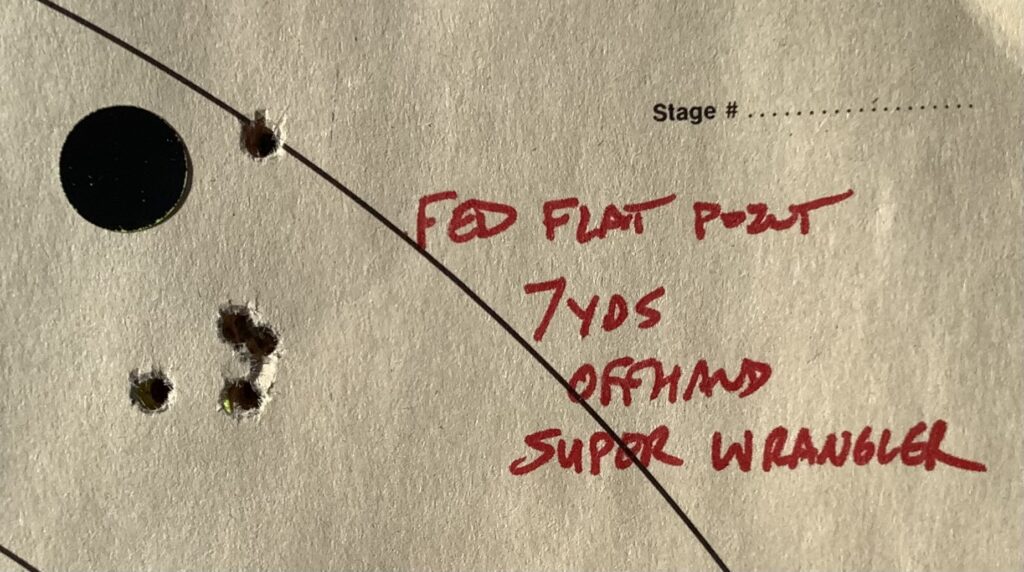
Additionally, filing the tips of the bullets off had no negative effects on accuracy. My testing of hollow point and flat nose cartridges from the same box indicated that the flat noses grouped just as well as, if not better than, the unmodified hollow points. You can certainly shoot minute-of-squirrel with these homemade flat points!
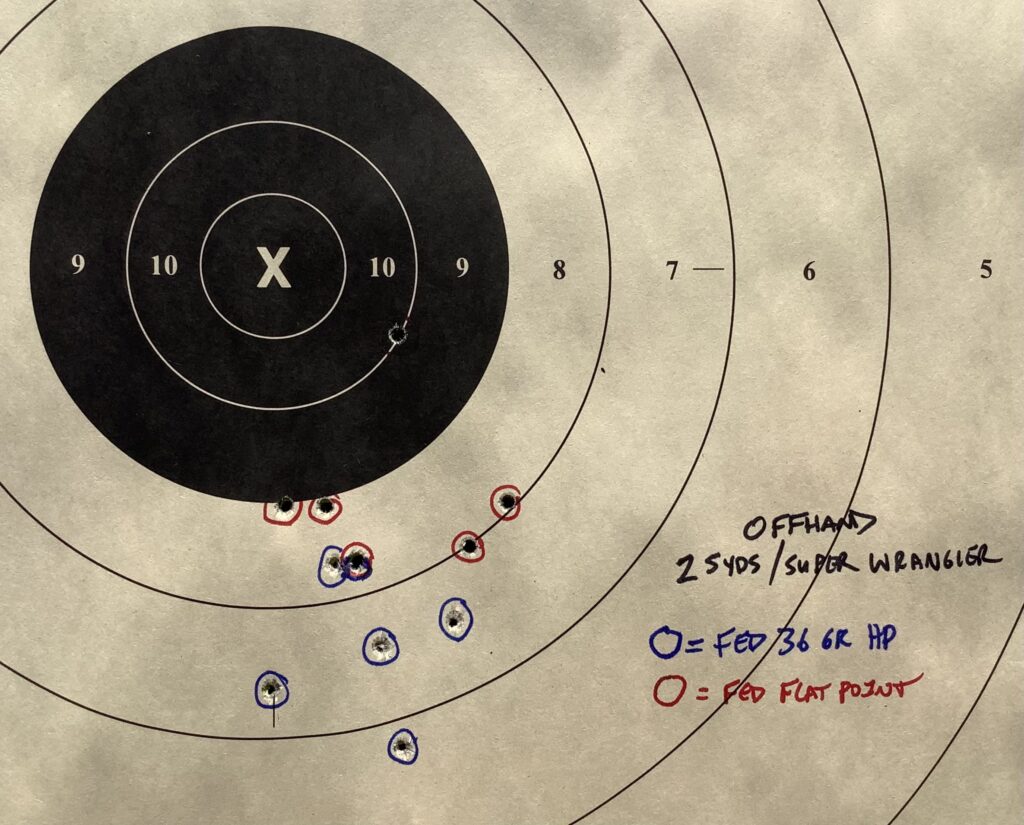
Cheap Magic
The rimfire hunters I know lean towards the .22 Magnum when they need to hit harder, and the .17 HMR when they need to shoot flatter and farther. There’s certainly a lot to be said for those excellent calibers, and I wouldn’t try to dissuade anyone from using them.
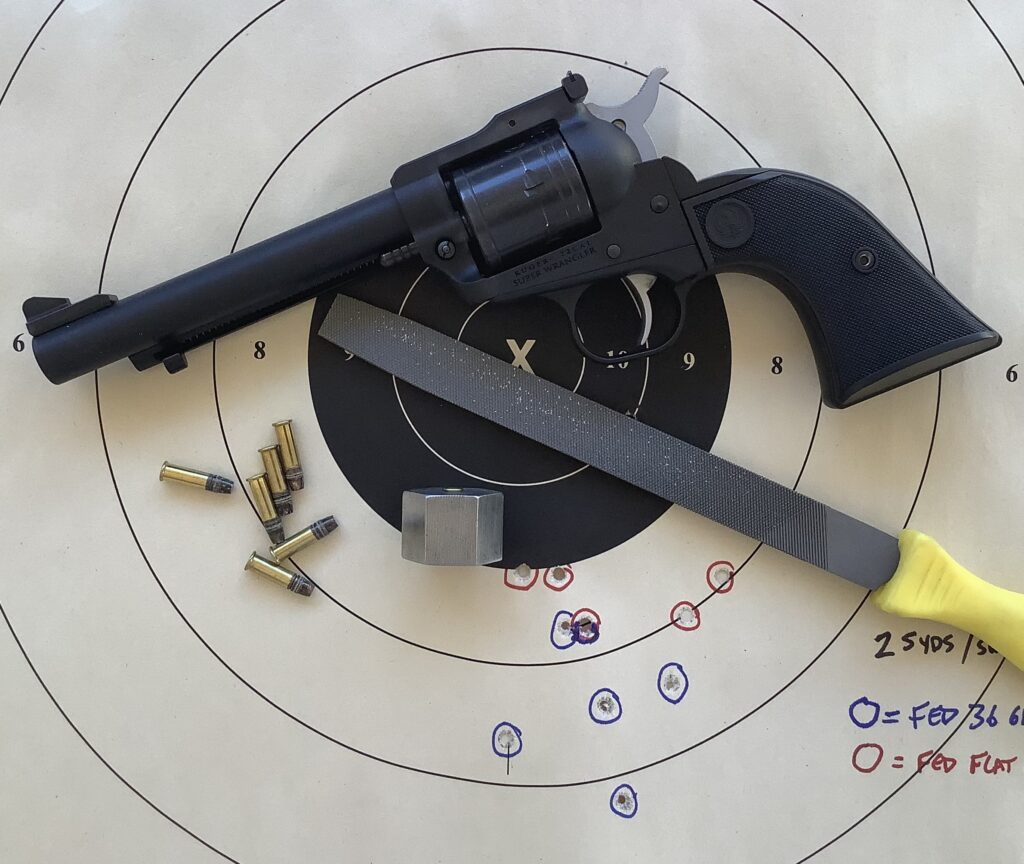
But I’ve gotta say that I was really pretty impressed with the change in performance that resulted from putting a flat point on the lowly .22 LR. It really made a dramatic difference in how hard the little bullets hit, and I suspect there’s no better way to squeeze an extra bit of performance out of them.
There’s no magic bullets out there, but there might be a little magic involved in flat-pointing the .22LR!
*****
Endnotes
-
- From Ed: “As you know, .38 Spl LRN commonly makes a 180-degree ‘flip’ during the first 6-8 inches of soft target penetration, continuing base-first. A flat nose of 1/2 bullet diameter eliminates the ‘flip,’ so the bullet continues nose forward in a straight line. You can make a trim die by taking a piece of .38 revolver barrel and running a .380″ diameter chucking reamer in to a depth of 1.25″, cutting the die off to 1.40″ then case hardening it to make it file hard. A gang die can be made by grinding off and case hardening a scrap revolver cylinder.”
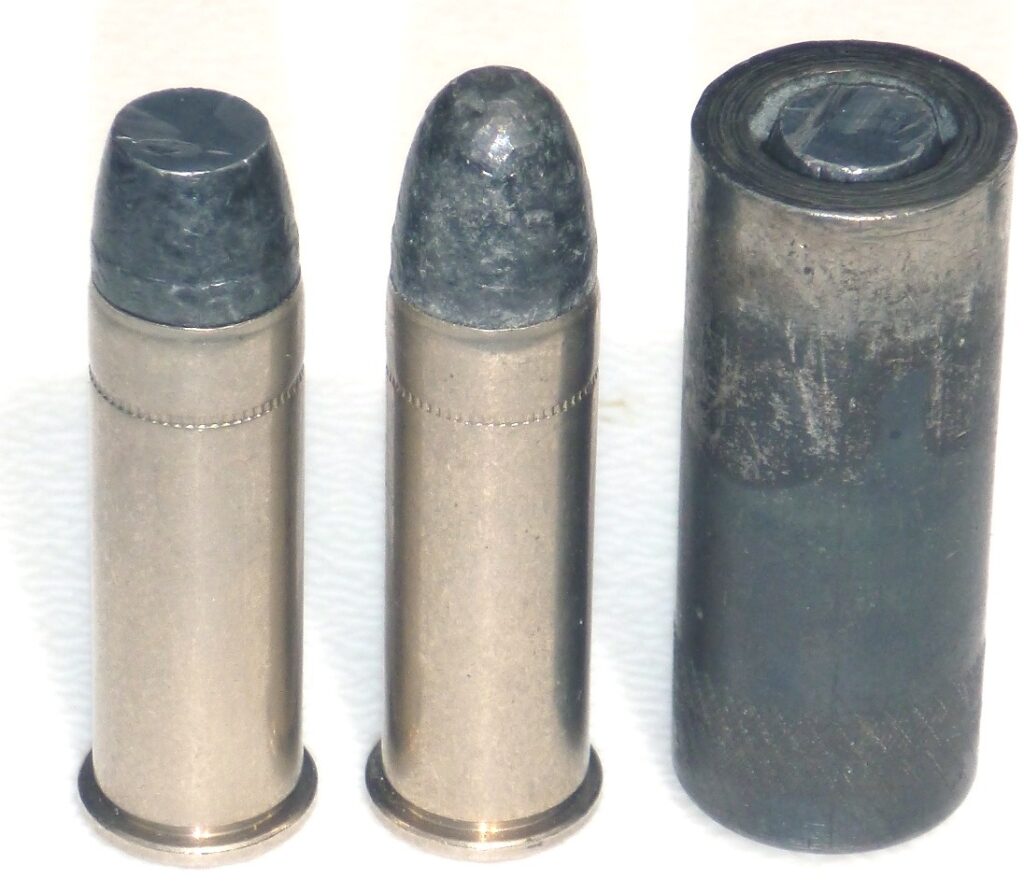
-
- When I contacted Mr. Waltz, he indicated that he had no more dies in stock, and it seemed unlikely he would be making any more of them.

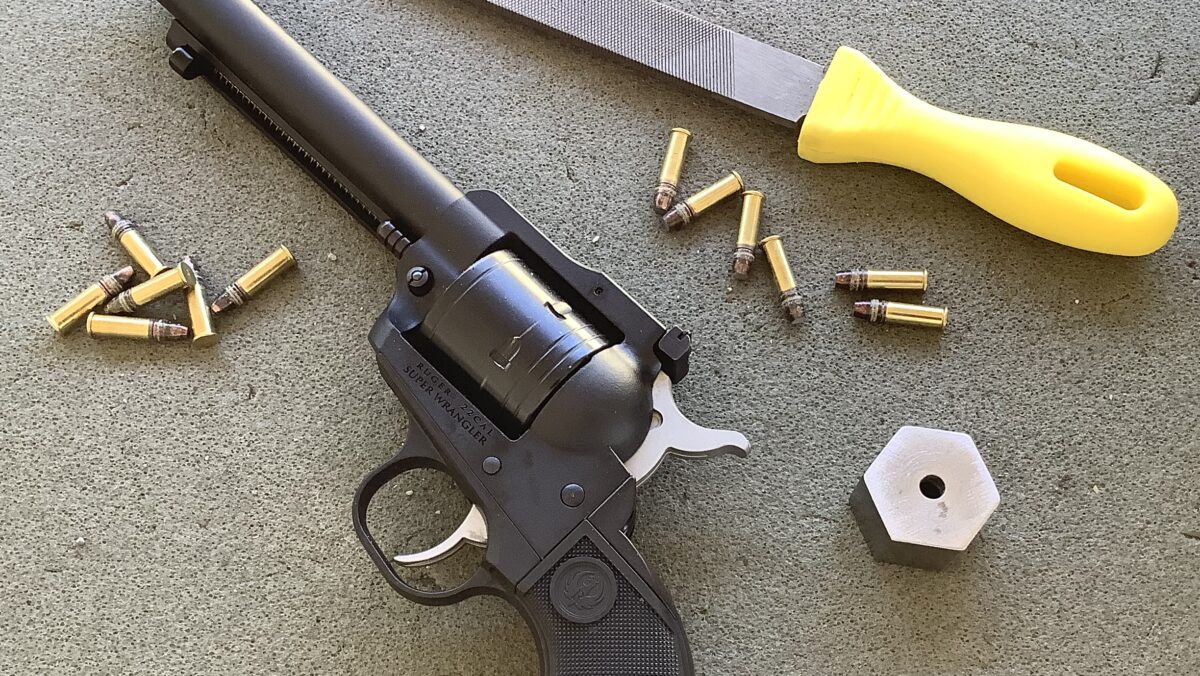
Cool article, Mike. It looks like I’ll have a small project this weekend: making my own flat-pointing .22 long rifle cartridge die.
More than 50 years ago, I used to ride dirt bikes near McCain Valley, that is, in Anza-Borrego State Park. And I shot a lot of .22s there, too.
Let me know about your results, Sir! Cool connection about the Anza Borrego—it’s a neat region.
Your latest article inspired me so much that I just had to fabricate my el cheapo version of Roy’s .22 LR bullet flat-pointing die.
Lacking a metal shop, and even a drill press (my vintage Sears Craftsman machine gave up the ghost a few months ago), I used a scrap piece of hard, dense teak and a large washer that I drilled and countersank with screws as a wear plate. Four passes per cartridge over a mill file produced a nice flat.
Though I haven’t shot any of these flattened bullets yet, they seem very evenly ground and hopefully will work fine.
Outstanding! Love the ingenuity. Looking forward to hearing about your results!
Oh, now, Mike. There’s ALWAYS something magic about .22!
So true, Sir!
Cool stuff, Mike! The bullet nerd that dwells within me wonders how much less the modified bullet weighs and if the reduction in weight gives a proportionate increase in velocity. Roy’s die or similar ones seem like an easy way to improve terminal velocity in the .22. Flat points are beautiful things!
Apparently, not enough coffee consumed yet- I meant “terminal ballistics” not terminal velocity!
I’m running on half of my cylinders this AM too, and didn’t notice it until you pointed it out! Yes, it would be fun to chrono these!
Kevin, I did some testing and the flat-pointing only removes a few grains of weight and I could not see any significant changes in velocity. They vary more round to round normally, than the weight loss seems to affect. I’ve been doing this same thing to FMJ 9mm and .45 bullets and they really work great, cutting clean holes. But I’m not sure now far down I can take the flat before the core might come out of the jacket in the barrel on firing. I’m working on finding that out. I’ve been shooting flat-pointed 9mm FMJ loads in a Taylor’s 9mm Remington 1875 clone (Uberti, an excellent gun) and they are laser accurate and great fun. Roy Huntington
Thank you, Mr. Roy, for the good info on the weight/velocity question on the .22’s. You are doing some neat stuff in your shop and I enjoy hearing/reading about it. Case in point: building and shooting custom 9mm “FMJ FP” thru a 1875 Remington clone. keep up the good work! Best- Kevin
I really enjoyed this write-up !! Kids today think they have it made, but they don’t. Growing up in the 1950s and 60, we didn’t have cell phones – you stopped at a pay phone. We didn’t have social media, we had junk yards and dumps. We didn’t need bicycle helmets because our skulls were so thick no amount of common sense could penetrate. We didn’t have seat belts in the cars, and the dash boards were metal. AND – probably best of all, I could ride my 3 speed bicycle the 15 miles from our house out to the county land fill, with a Ruger single action in a belt holster, and my .22 rifle slung over my shoulder – and no one gave it a second thought. Our notion of committing crime with a firearm was leaving a can unshot or a glass whatever unshattered.
There are many irresistible attributes the .22 LR has going for it. Economy is probably number one, but utility is definitely close behind. All things considered, the humble .22 LR punches a good bit above its weight, and as with many other revolver cartridges, bullet design is key.
In my youth, there were untold numbers of metal and later aluminum food and beverage cans that died a slow death being riddled with .22 bullets, especially the larger juice drink cans of the day. There was no desert-like area around my part of Central Florida at the time (sink holes and swamps, yes, deserts, no), but there were two really great land fills / junk yards, one of which is buried below Walt Dismal World.
My Sears .22 single shot rifle had plain open sights. Putting a scope on a .22 ? Heaven forbid. My Super Single Six that was a gift from my grandfather became my favorite revolver of all time. I did manage to splurge and buy two boxes of Winchester .22 WMR that took me over 10 years to burn through. But the .22 Long Rifle – At $.39 cents a box of 50 rounds at Sears (where else?), or $3.50 a brick of 500, ( or 70 soda bottles returned for deposit ) you could spend a good part of a Saturday adding lead to the environmentalists’ climate nightmares.
The powers that were took a blind eye to us making short work of bottles, cans, and whatever else was dumped in the landfill. Those were our stationary targets. The rodents, snakes, and other pests provided needed ‘combat shooting’ experience for us dumpster snipers and our .22 rifles- even though the rodents weren’t shooting back. We didn’t think of it quite like a plinker’s paradise at the time, but it was. By the time everything was closed down in the mid 1960s, the cleanup and development started for Dismal World to infiltrate and turn Central Florida into a third world sewer. The sheer number of spent .22 cases must have raised a question of what war was fought here.
Okay, back to 2024, now I’m going to have to make up some and see how they function in a 10/22 and my Ruger Mk I pistol. OH . . . Mike, are you having any feed or extraction/ejection issues out of your Wrangler ?
Sir, your comment was more enjoyable than the article! I hope everyone makes it down here to read it!
The past is a foreign land, indeed.
No feeding or extraction issues with the Super Wrangler! I had some issues with the hammer freezing up which took a few returns to Customer Service, but I think it’s squared away now after the hammer assembly was replaced.
Dumpster sniper! What an excellent term!
Mike this was a great article, thank you. Roy is a pretty talented fellow in many areas
The flat point on rimfires sure makes sense. Have you used the Federal Punch .22 long rifle rounds on any squirrels or other varmints?
A K22 and plenty of ammo made a mid night shift bearable on the rare slow nights. The feed mill on the outskirts of town was a smorgasbord for rats so we felt it was our civic duty to thin them out. You know Health issues used to fall under LE jusidiction.
The rat eradication program became pretty popular around the state with other departments until our world began to change.
I sure am glad that homicides of Cottomouths only has a 7 year limit.
Great image of Kevin’s .44 Special rig by the way.
Hah! It was simply your duty, Tony! What a faithful public servant!
I haven’t used the .22 Punch on game yet. Maybe another reader here can tell us how it works?
Mike,
Thanks, as always, for your kind words. Your idea of shooting the full cans was brilliant and clearly shows what I was talking to you about when it came to my own experiences on the pesky grey squirrels on my land here. I’ve also been using sub-sonic .22s (CCI’s Quiet load) which I’ve flat pointed, through my supressed Remington 514 .22 rifle I built. In testing, it’s the same result only “more.” The round points (even if HP) will knock the squirrels down but they do tend to run off or hide unless a really fatal shot is made (which isn’t always easy, as we all know)! The flat point, even with a simple body shot makes them “DRT” as we used to say when I was a cop as we gazed at a deceased bad guy … “Dead Right There.” I encourage people to make one of these simple dies. Any piece of metal thick enough to use works fine. Find a drill allowing the case to go in, but not the rim, and allows the lead bullet to stick out the amount you’d like to file off. The die doesn’t even need to be particularly hard, especially if you are careful when you file. Roy Huntington
I’ve been having lots of fun, and really appreciate you sharing it with me. I’ll eventually get a chance to test these on some squirrels, if I can get out to my buddy’s almond farm in the Central Valley.
It was interesting to hear about your experiments with the centerfire FMJs. What a neat platform to test those 9mms in! Steve Tracy REALLY loved the Taylor’s 1875 Remington he tested for us. They did a super job on that one. I wish my TC9 had received the same Taylor Tuned attention as the 1875s get.
Years ago, after reading an article in a magazine, by the late Hal Swiggett, order a small game bullet die from Hanned precision. They were the company making the Taylor 22 die then. Their website had many many, safisfied customers write in about the die. I also carried on a email correspondence, with a gentleman who had done alot of testing with the die and accuracy. Still have it saved in my notebook, old school paper style! and refer to it time to time.
CCI has been making their 40 grain Small Game Bullet for decades for the same reasons
Thanks for pointing those out, Brett. I’d overlooked them.
Interesting and fun article. The question that popped up in my mind was, does changing the bullet shape affect long-range (50+ yards) accuracy? Not that I shoot that far; just wondering.
I really like your mix of historical and (semi-)technical articles along with your reviews of new and old (Oops, I meant classic) revolvers. Being kind of a classic myself, I enjoy reading about revolvers I’ve either owned or lusted for.
Thanks 1811, glad we’re keeping your attention! I haven’t shot any of the flat points at 50 yards yet, but I’ll do that at my next range visit and report back!
Mike,
I’ve shot groups using flat-pointed ammo with my Rem. 514 single shot rifle out to about 40 yards and they hover in the 1” or so range. It’s not a target rifle and the question posed leads me want to use my Anschutz target rifle to give it a more serious go out to 50. I’ll report back when the weather clears here.
Roy H.
Ditto on CCI’s Small Game Bullet load. A few decades ago, when I still had a scope on a Marlin 39M lever gun, it gave me the tightest group of several loads that I tested. (I’m having trouble recalling whether that was at 25 or 50 yards.)
In centerfire calibers, some may recall that Julian Hatcher, in his Textbook of Pistols and Revolvers, recommended the Colt versions of some of the S&W revolver cartridges because the Colt loading used flat-point bullets, which Hatcher said produced more “shocking power.”
Thanks Stephen, great point (pun intended). ; ^ )
Indeed I do remember Colonel Hatcher making that point (!) in his discussion of my favorite cartridge to experiment with, the .38 Smith & Wesson (NOT Special) and its flatpointed twin, the .38 Colt New Police. I’ve chronographed vintage factory loadings of the .38 CNP with 150g flatpoint bullets at 740 and 770 fps from a 4″ S&W Mod. 33-1. I imagine they were equal or superior to the old police standby .38 SPL 158g LRN at 770 (4″ bbl.), although the latter rated 850 from a 6″ barrel. Unfortunately, I didn’t have a 6″ revolver in which to test that 770 fps .38 CNP load.
Great info LAMan, thanks for sharing it. I didn’t realize the shorter .38s approached those kinds of velocities!
What is the advantage over the Remington Vipers?
I’m not sure there is one, other than the fact I didn’t have any Vipers, but I did have a bucket full of round noses and a file. ; ^ )
I suppose there could be an economy, if the Vipers are priced at a premium, and it’s nice to be able to fabricate a facsimile, when the Vipers aren’t in stock, but honestly, it’s just kinda fun to tinker with.
I made several of these dies in the 90’s. I used 3/4″ square stock and drilled a hole that allowed the tip of the bullet to barely protrude. A second hole, larger than the first allowed the case to fit snuggly. I heated them until orange red and dumped them in a soda can 2/3 full of old oil. This hardened them and allowed the file to take the lead without shortening the die.
Accuracy was not effected at 50 yards, and groups were very close at 100 yards. My main use at the time was on the cheaper round nose ammunition.
John, that’s a neat tip about hardening the dies, thanks! Also appreciate the feedback on 50 and 100 yard accuracy!
Good article!
I have one of the gadgets I bought a loooong time ago. It seemed to work fine on garden-variety .22 ammo, and the Aguila 60 gr. SST(?) round, too. They both shot very well at 50 yards.
Not sure if my cut-off tool is hardened, but, at 85, I doubt I will modify enough rounds to shorten it any significant amount.
If I can find my Propane torch, and if it will heat the thing red, I may try to harden (re-harden ?) it just to see!
Mike, great article! Being of the younger(ish) generation I’ve never heard of this or even thought of it. I love the idea of making it a semiwadcutter and looking at the new Federal 22 punch it looks like they followed the same recipe. I would love to get one of these or make my own, but I really like the simplicity of Roy’s design and the bulkiness of it for easier handling. Thanks for another great writeup!
Glad you enjoyed it Ryan! I hope you’ll have fun playing with them when you get set up to make them.
Because your articles are well researched and documented, a company called The Hanned Line offered a tool like this, called the SGB tool (before CCI came out with the load), in the early 1990’s. Dean Grinell featured it in some of his Gun Digest publications. Over a decade ago, I emailed Paco Kelly to ask if he would make one for the 38 special 158 lead round nose (never heard back). This would still be a great option. Great article!
Thanks for the info Dean! Much appreciated!
Now you’re talkin.’ Wonder if I can cobble up a .38 Special version out of readily available household materials.
Or maybe Roy can help us out here….
Viejo,
I’ve beat you to the draw on it. If you can lay hands on a piece of hardwood or exotic hardwood, you can start there. Just make the wood thick enough so the amount of bullet nose is sticking out that you want to file off. Then drill a hole allowing the bullet and case but will stop the rim. Now file away! You’ll find if you file carefully, you won’t work away the wood much at all. Especially in the limited numbers you’ll likely do. Roy
I have found .38 jacketed flat points lately. I have used them in a Rossi lever action rifle. It seems they would offer some of the same benefits as the Keith style bullets. They definitely cut nice clean holes in paper targets.
It’s pretty impressive how much of a difference there is in effect on a target when you go from round nose to flat point. That suggests to me that, if hollow point expansion is unavailable, a flat point is the way to go. Subsonic .22LR with flat point bullets could be an effective, and relatively quiet, way to deal with squirrels.
Fifteen years ago, “Buckshot” on Cast Boolits made up a blind die for me to use to “smush” a flat nose on cast bullets prior to assembling them into a handloaded .38 S&W/ Colt New Police cartridge.
Just screw the die into your press, place a suitably flat piece of steel atop the ram, put the bullet on the steel piece, then operate the press handle to raise the ram and “smush” the bullet nose against the blind die’s flat surface. Adjust by trial and error to “smush” a flatpoint to your liking, then lather, rinse, repeat, and watch the pile of FPs grow rapidly. Resize the bullet if necessary before loading, as more aggressive “smushing” can cause the bullet shank to swell.
I could handily convert a pile of .15-.20″ meplat SWCs into sharp-shouldered .30-.32″ meplats, i.e. practically an ogival WC with a vestigial shoulder. In other words, essentially a WC, but with the reduced bearing surface of a SWC. A LRN bullet can be converted using the identical process, albeit with less radical meplat and lacking the sharp cutting edge of the smushed SWC or filed LRN. Accuracy at 20-30 yards seemed unaffected, and penetration through water jugs was both straight and deep.
Safety WARNING re. my post on bullet “smushing” using a blind die: Let me state explicitly that this procedure is ***NOT SAFE*** to use on loaded cartridges, as you would compress the bullet into the case and spike pressures DANGEROUSLY. Use this procedure solely on **unloaded** bullets prior to handloading a center fire cartridge. It does not serve to safely alter loaded .22 rimfire ammunition!
Thanks LAMan for the great info and the important safety warning.
I’ve seen reports that indicate internal case pressures can nearly double on .40 S&W ammo with significant bullet setback, so it’s an important point you make—don’t push the bullet deeper into the case!
It’s worth noting that Hordany introduced the Drag Variability Reduction Technology which has a flat point projectile. I suspect that they are using a Pareto Principle of using a ration of 20/80. This means that the diameter of tip is 20 % of the diameter of the rim. Another phenomenal is the 1/3 ratio as seen on an equal sided Triangle. This means that the diameter of the tip would be 1/3 the diameter of the rim. Just a thought that perhaps better accuracy could be achieved using these ratios. My guess is that the flat nose actually creates more drag during flight thus minimizing its Yaw (rotation of the nose up/down of the bullet away from the line of flight) and Precession (rotation of the bullet around the center of flight). Perhaps it would make more sense to make a calculated cut than just chopping off the tip. Just a wild guess!
It’s a .22 LR, Carlos! I’m not building the Space Shuttle, here. 😁
Take this a step farther and you will understand why a DEWC (double ended wadcutter) is my go-to bullet for a 38 snubby.